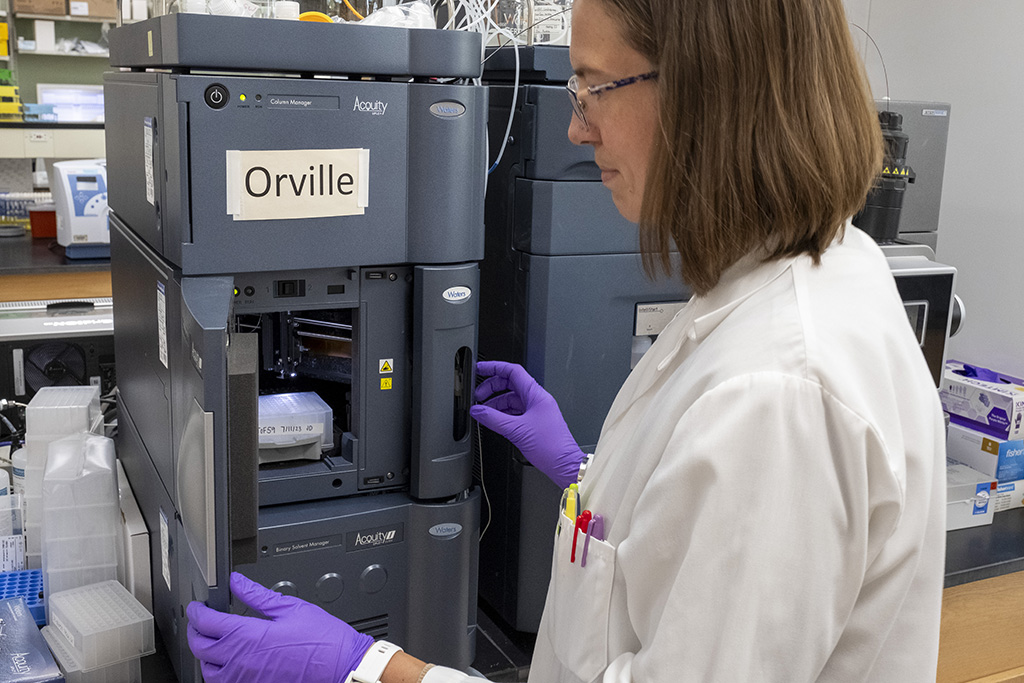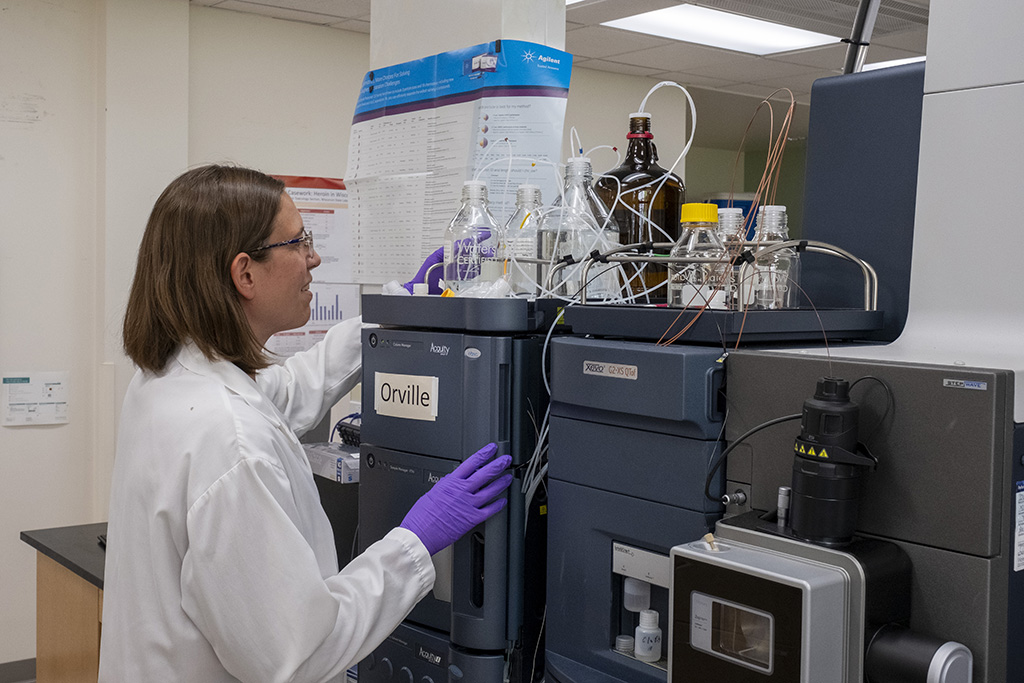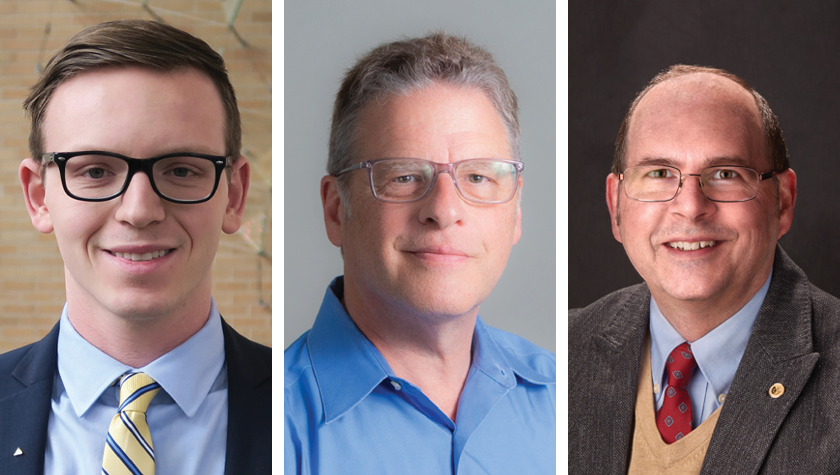School of Pharmacy Assistant Professor Heather Barkholtz is working to deepen our understanding of new drugs of abuse and how to detect them
By Nicole Sweeney Etter
“Delta-8 THC sold here!” announces the sign outside a cigarette shop. While Wisconsin continues to prohibit cannabis for medical and recreational purposes, it’s easier than ever to get cannabis-derived products that hover in legal gray territory and are still capable of delivering a high. But how much do we know about these substances and how they affect the body?
According to forensic toxicologist Heather Barkholtz, an assistant professor in the University of Wisconsin–Madison School of Pharmacy’s Pharmaceutical Sciences Division, the answer is not nearly enough. Barkholtz, who has a joint appointment with the Wisconsin State Laboratory of Hygiene (WSLH), is determined to expand the limited research on drug impairment and develop better tools of detection for illegal substances. That would help both law enforcement and her colleagues at WSLH, the state’s public health laboratory that processes nearly 90 percent of samples from impaired drivers statewide.
“I’m the only faculty member studying forensic toxicology in the country who works alongside actual state practitioners.”
—Heather Barkholtz
Forensic toxicology is an ever-changing job: Delta-9-tetrahydrocannabinol (Delta-9 THC) is the main psychoactive component of the cannabis (marijuana) plant, but hemp-derived products that contain less than 0.3 percent Delta-9 are legal, and new variants continue to arrive on the marketplace.
“I call it forensic tox whack-a-mole,” Barkholtz says. “As soon as a certain substance is made illegal, something new pops up, so we’re always chasing those novel psychoactive substances and trying to develop tools to be a little bit more proactive instead of reactive to the shifting drug markets.”
Field-inspired research
The challenge appeals to Barkholtz, who worked in material science and engineering research on lithium-ion batteries and fuel cells before transitioning to forensic toxicology.
“I like to see my research leave the lab and go out and have an impact on society and things I care about,” she says. “I found that toxicology was directly applicable to people, particularly forensics. You’re increasing public safety and you’re providing valuable tools and knowledge to community partners, policy makers, and practitioners.”

She previously managed Wisconsin’s breath alcohol toxicology program but was eager to do more research — and the new joint position with the School of Pharmacy and the Hygiene Lab, which is part of UW–Madison, was especially intriguing. The position was created in 2021 to enhance translational research and innovation in opioid and drug abuse surveillance.
“I’m the only faculty member studying forensic toxicology in the country who works alongside actual state practitioners,” she notes. “That means that we have great insight into what their pain points are and what they struggle with, and then that leads to our research. One of the things we’re working on is developing new ways to detect drugs of abuse in biological specimens, meaning blood or urine, and we’re trying to find methods that can detect a wide variety of different drugs in a short amount of time because we receive so many samples from across the state.”
Creating new tools of detection
One of the Barkholtz Research Group’s projects focuses on better detection methods for new and emerging cannabinoids, which are compounds found in the cannabis plant.
“After the 2018 Farm Bill that legalized CBD and hemp in the United States, a lot of jurisdictions with very restrictive cannabis laws have seen an onslaught of THC isomers, meaning that the molecular weight is the same, but [drug producers] are kind of shifting the bonds around so that it evades our detection,” she explains. “They’re making very small tweaks to the chemical structure, both naturally and synthetically.”
That led to the popularity of Delta-8 THC. And then as Delta-8 came under more scrutiny and started being restricted in some states, drug producers shifted to Delta-10 and then different isomers like THC-O acetate, Barkholtz notes.
“It’s a really unique environment where my students are directly interacting every day in the lab with people who are running samples for casework.”
—Heather Barkholtz
“Some reports have shown that states that have a more restrictive cannabis law, like Wisconsin, are seeing a lot more of the isomers,” she says.
But current drug tests are so precise that they only recognize Delta-9 and the hydroxy in carboxy metabolites of that THC compound. Barkholtz’s solution: develop wider scope assays.
“We’re working on one that will detect Delta-8, Delta-10, and a variety of other compounds that are available as certified reference materials, so that as the drug market continues to pump out these different THC analogs, we’ve got one method that’s able to detect a wide scope of them instead of just one,” she says. “We are trying to be responsive to the new cannabis landscape.”
Even in states where cannabis products are legal, product labels aren’t necessarily accurate — products could contain high amounts of THC or no THC at all, or toxic byproducts because of the manufacturing process.
“There’s just no oversight because they’re completely unregulated, and according to the DEA (Drug Enforcement Agency), they’re completely illegal, but they’re not enforcing those laws,” she notes.
Testing impairment in clinical trials
And how do these variants affect humans? More research is needed to inform both health and public safety, but clinical research on controlled substances is complex and uncommon.
“Many haven’t thought about how little we know about these drugs of abuse,” Barkholtz says. “But we need to know how these drugs impair people so we can make data-driven policies and interventions and train our law enforcement officers on what to look for. We don’t know if Delta-8 impairs in the same way that Delta-9 does because the small changes in the chemical structure can really change how that molecule interacts with the receptor.”
To help fill in the gaps in the research, Barkholtz is teaming up with Paul Hutson, professor in the School’s Pharmacy Practice and Translational Research Division and director of the UW Transdisciplinary Center for Research in Psychoactive Substances, on a pilot project to assess the impairment and pharmacokinetics of Delta-8 versus Delta-9 in humans.

“The goal of it is not really to get statistically significant data; it’s to see how the process goes and get all the regulatory approvals in place so that when we do a larger trial, it’s a lot easier and faster,” Barkholtz explains. She hopes to substantially expand the pilot project in the future.
Barkholtz suspects that Delta-8 is about 50 to 75 percent as impairing as Delta-9 based on animal preclinical models and a small amount of human subject trials from decades ago, but much is still unknown.
“I find it equally frustrating and exciting when I dive into the literature to try to answer a question and there’s just nothing,” she says. “It’s really exciting for me because I just see this wide-open space where we can answer a lot of questions and have a lot of impact on real-world problems. Like what does it look like after you consume Delta-8 versus Delta-9? How much can you consume before you become too impaired to drive a car? Those questions we don’t really have great answers for.”
Barkholtz is also interested in studying the differences between l-methamphetamine, which is available over the counter as a nasal decongestant, and d-methamphetamine, which is a strong central nervous system stimulant. After a court case involving an impaired driver brought the issue to her attention, she discovered there was little peer-reviewed research on the topic. Wisconsin state statute defines methamphetamine as a restricted controlled substance but doesn’t differentiate which isomer, so Barkholtz has applied for funding to conduct a small clinical trial. In July, she also published a systematic review of methamphetamine isomers in ACS Pharmacology & Translational Science.
And her interactions with her colleagues at the Hygiene Lab continue to inspire her research interests.
“It’s a really unique environment where my students are directly interacting every day in the lab with people who are running samples for casework,” she says. “It’s created a really fruitful research environment, and that has led to us trying to establish pathways to do these human impairment clinical trials, which are not in a lot of locations in the United States. We’re hoping to be able to contribute to the forensic tox community and the public safety community through these research projects and collaborations.”
